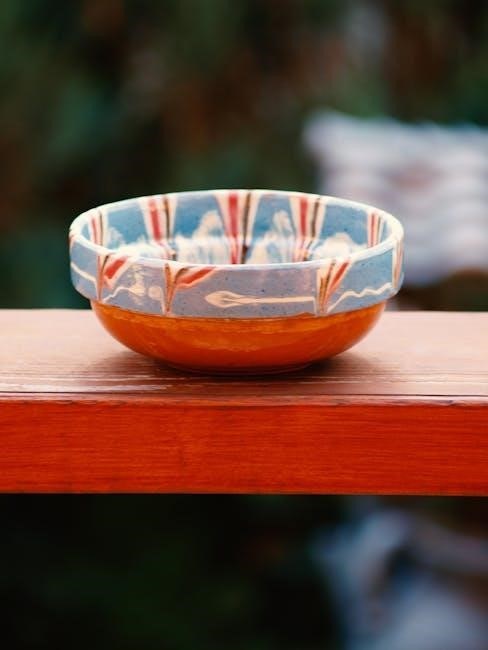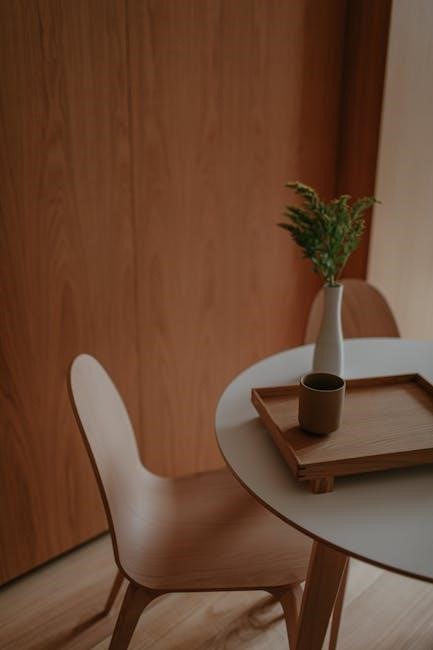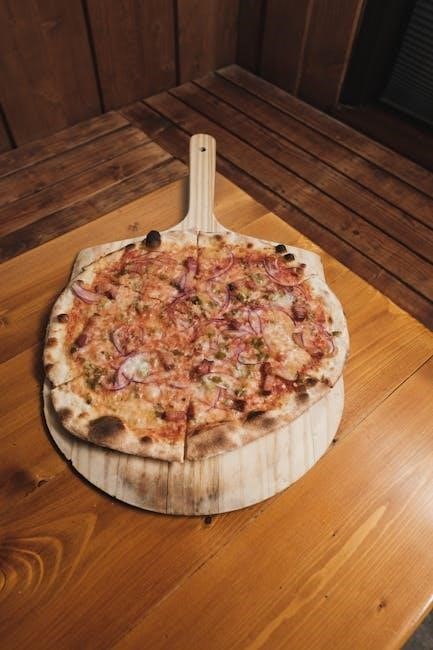
round dining table size guide
A round dining table offers a unique blend of intimacy and functionality, creating a welcoming atmosphere for gatherings. Its circular design fosters equal interaction among diners, making it ideal for both casual and formal settings. Perfect for smaller spaces, round tables enhance traffic flow while providing ample seating. Available in various sizes and styles, they suit diverse decor preferences, ensuring a harmonious fit for any home.
Popularity and Benefits

Round dining tables have gained immense popularity due to their unique ability to enhance social interaction and create a sense of equality among diners. Their circular design eliminates sharp corners, making them ideal for smaller spaces while ensuring smoother traffic flow. The absence of corners also allows for more flexible seating arrangements, accommodating guests comfortably. Round tables foster intimacy, making them perfect for family meals or casual gatherings. Additionally, their sleek and timeless appeal complements various interior styles, from modern to rustic. The versatility of round tables lies in their ability to adapt to different settings, ensuring a harmonious blend of form and function in any dining area.
Importance of Size in Dining Experience
The size of a round dining table plays a crucial role in ensuring a comfortable and enjoyable dining experience. A table that is too small can make meals feel cramped, while one that is too large may overwhelm the space. The right size ensures ample elbow room, easy conversation, and a balanced aesthetic. Proper sizing also allows for smooth traffic flow around the table, creating a more functional and inviting environment. Additionally, the table’s size should align with the number of diners and the dimensions of the room, ensuring a harmonious fit that enhances both practicality and ambiance.

Standard Round Dining Table Sizes
Round dining tables typically range from 36 to over 72 inches in diameter, offering options for small, medium, large, and extra-large spaces. These sizes accommodate various seating needs, ensuring comfort and functionality while fitting seamlessly into diverse room layouts.
Small Tables: 36-44 Inches
Small round dining tables, measuring 36 to 44 inches in diameter, are perfect for intimate gatherings and compact spaces. They comfortably seat 4 people, fostering cozy conversations and a warm ambiance. Ideal for small dining rooms, breakfast nooks, or apartments, these tables maximize space while maintaining functionality. Their compact size allows for easy movement and efficient traffic flow, making them a practical choice for everyday use. When paired with slim chairs, they create a sleek, modern aesthetic. For optimal comfort, ensure at least 36 inches of clearance around the table to accommodate seating and movement.
Medium Tables: 48-54 Inches
Medium-sized round dining tables, ranging from 48 to 54 inches in diameter, offer a balance of space and comfort for small to medium-sized gatherings. They are ideal for seating 4 to 6 people, depending on chair size and personal space preferences. This size is versatile, fitting well in modest dining rooms while providing enough room for conversation and movement. A 48-inch table is perfect for everyday meals, while a 54-inch table accommodates larger families or occasional guests. Ensure at least 36 inches of clearance around the table for comfortable seating and traffic flow. This size is a popular choice for its practicality and aesthetic appeal in various home settings.
Large round dining tables, measuring between 60 and 72 inches in diameter, are ideal for seating 6 to 8 people comfortably. This size is perfect for larger families or those who frequently entertain guests, offering ample elbow room and space for shared dishes; A 60-inch table provides a cozy yet spacious setup, while a 72-inch table creates a grand dining experience. Ensure at least 36 to 42 inches of clearance around the table for easy movement. This size is great for formal dining rooms or open-concept spaces, blending practicality with elegance to create a welcoming atmosphere for memorable gatherings.

Extra Large Tables: Over 72 Inches
Large Tables: 60-72 Inches
Round dining tables measuring 60 to 72 inches in diameter are perfect for seating 6 to 8 people comfortably. This size is ideal for larger families or those who frequently host guests, offering ample space for shared dishes and conversations. A 60-inch table provides a spacious yet intimate setting, while a 72-inch table accommodates bigger gatherings with ease. Ensure at least 36 to 42 inches of clearance around the table for smooth movement. These tables are great for formal dining rooms or open-concept spaces, blending practicality with elegance to create a welcoming atmosphere for memorable meals and special occasions.
How to Measure Your Dining Room
Measure your dining room’s length, width, and any obstructions to determine the ideal table size. Ensure there’s enough space for chairs and comfortable traffic flow around the table.
Assessing Room Dimensions
Measuring your dining room accurately is crucial for selecting the right round dining table size. Use a tape measure to record the room’s length and width, noting any obstructions like doorways or windows. Consider the space needed for chairs and comfortable movement around the table. The standard dining table height is 28-30 inches, so ensure your measurements account for this. Assessing the room’s layout helps determine the maximum table size that fits without compromising traffic flow or comfort. A well-measured space ensures harmony between the table and the room, creating an inviting atmosphere for dining and socializing.
Considering Traffic Flow
Ensuring proper traffic flow is essential when choosing a round dining table size. Allow at least 36-48 inches of clearance between the table and walls or other furniture to enable easy movement. Round tables are ideal for smaller spaces as they eliminate sharp corners, reducing obstacles. Measure the room’s pathways to ensure comfort for everyone, even when chairs are pulled out. Adequate space prevents overcrowding and makes the dining area functional. Consider the table’s height (typically 28-30 inches) and chair sizes, as they affect overall clearance. Balancing table size with room dimensions ensures a smooth flow, creating a comfortable and accessible dining environment for all.
Accounting for Chair Size
Chair size significantly impacts the overall dining setup, as larger chairs require more space around the table. Standard dining chairs typically measure 17 to 20 inches in width, but armchairs or bulky designs may need additional clearance. When selecting a round table, ensure there’s enough room for chairs to be pulled out comfortably without hindering movement. Measure the chairs’ dimensions, including their depth and width, to calculate the total space needed. Consider the table height (usually 28-30 inches) to ensure chairs fit seamlessly. Balancing chair size with table size ensures a comfortable and functional dining area, preventing overcrowding and enhancing the overall experience.

Calculating the Ideal Table Size
To determine the perfect round dining table size, consider the number of diners, space requirements, and chair dimensions. Measure the room, allowing at least 36 inches of clearance around the table for comfortable movement. Use standard size guides: small tables (36-44 inches) for 4 people, medium (48-54 inches) for 4-6, large (60-72 inches) for 6-8, and extra-large (over 72 inches) for 8 or more. Ensure the table height (typically 28-30 inches) aligns with chair heights. Balance functionality and aesthetics to create a harmonious dining area that accommodates everyone comfortably.
Number of People and Seating
The number of people a round dining table can seat depends on its size and the desired comfort level. A 48-inch table typically seats 4-5 people, while a 54-inch table accommodates 5-6. Larger tables, such as 60-72 inches, can seat 6-8 people, and extra-large tables over 72 inches can fit 8 or more. For a comfortable dining experience, allow 24-30 inches of space per person to ensure ample elbow room and easy conversation. Consider the chair size and how it affects seating capacity, as wider chairs may reduce the number of people who can sit around the table. Properly sizing the table ensures a balanced and enjoyable dining experience for everyone.

Space per Person Requirements
When selecting a round dining table, it’s essential to consider the space per person to ensure comfort and ease of conversation. A general rule is to allow 24-30 inches of space per person, measured from the center of the table to the edge. This ensures adequate elbow room and prevents the table from feeling cramped. For smaller tables (36-44 inches), this guideline still applies, as overcrowding can make the dining experience less enjoyable. Larger tables (60-72 inches or more) naturally offer more space per person, enhancing comfort. Always balance seating capacity with chair size, as wider chairs may require additional space. Proper spacing ensures a harmonious and functional dining setup for all guests.
Table Height Considerations
The standard height for round dining tables is typically between 28 and 30 inches, ensuring comfort for most people. This height aligns with average chair dimensions, providing adequate legroom and promoting relaxed posture. Taller individuals or specific decor styles may require adjustments, but deviating from this range can compromise comfort. Measuring chair height is crucial, as it should allow a 10-12 inch gap between the chair seat and the tabletop. Proper table height ensures easy conversation and movement, while also maintaining a balanced aesthetic. Always consider the room’s overall design and the chairs’ proportions when selecting a table height for optimal functionality and style.
Material and Style Considerations
Round dining tables come in various materials like wood, metal, and glass, each offering unique aesthetics. Wood provides warmth and tradition, while metal adds modern sleekness. Glass tables create a sense of openness, ideal for smaller spaces. The style should complement the room’s decor, whether rustic, contemporary, or minimalist. Material choice impacts durability and maintenance, with wood requiring more care than metal or glass. Additionally, chair styles and sizes should align with the table’s design for a cohesive look. Ultimately, the material and style chosen will define the table’s functionality and visual appeal, ensuring it fits seamlessly into the dining area’s ambiance.
Impact of Material on Size
The material of a round dining table significantly influences its size and overall aesthetic. Wood tables, for instance, can feel bulkier due to their thickness, often requiring a slightly larger diameter for comfort. Metal tables, with their sleek profiles, can appear more compact while maintaining functionality. Glass tables create a sense of openness, making even larger sizes feel less imposing. The choice of material also affects the table’s weight and stability, with heavier materials like solid wood or metal often better suited for larger tables. Additionally, decorative elements like carved legs or intricate designs can impact the table’s proportions, making some materials more suitable for specific sizes and spaces.
Style Choices and Size
Style choices significantly influence the size of a round dining table, as design elements can enhance or detract from the space. Modern designs often favor sleek, minimalist tables with smaller diameters, perfect for intimate gatherings. Rustic or traditional styles may incorporate larger, statement-making tables to create a grand ambiance. The table’s base design, such as a pedestal or multiple legs, also affects its visual proportions and functionality. Additionally, the overall aesthetic of the dining room, whether formal or casual, plays a role in determining the appropriate table size. Balancing style and functionality ensures the table complements the room while providing ample seating and comfort for diners.
Selecting the right round dining table size is crucial for creating a functional and inviting dining space. By considering room dimensions, chair sizes, and personal style, you can choose a table that enhances comfort and aesthetics. Whether your preference is modern minimalism or traditional grandeur, the ideal table size ensures seamless traffic flow and intimate gatherings. Remember, the goal is to strike a balance between form and function, ensuring your dining area becomes the heart of your home. Use this guide to make informed decisions and transform your dining space into a warm and welcoming hub for everyday meals and special occasions alike.